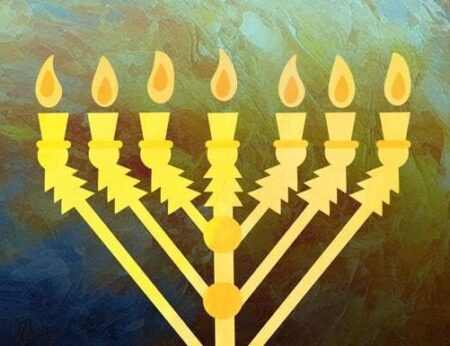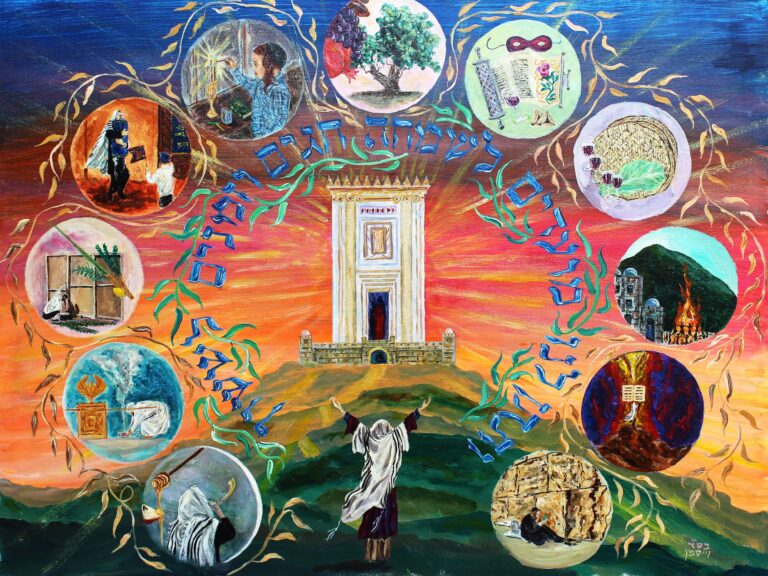Sanctifying the Menorah of Our Face

A 'How-to' Guide for Likutei Moharan 21:2
In last week's article entitled They Found One Sealed Flask of Oil, we discussed the meaning of a rather cryptic statement in the Sifra di'Tzniuta (Zohar ha-Kadosh, Terumah 178a): עַתִּיקָא טָמִיר וסָתִים זְעֵירָא דְּאַנְפִּין אִתְגַּלְיָיא ולָא אִתְגַּלְיָיא (Atika is hidden and sealed; Ze'ir Anpin is reveal and not revealed). The light of Keter, which corresponds to Atika in the Zohar's statement, is completely hidden from us in Olam ha-Zeh. It will only be revealed in the days of Mashiach. This is why it is also known as the Light of Mashiach, or Ohr Ganuz, i.e. the 'Hidden Light'. However, there is another very high light of Torah that is accessible to us even in this world, but only under certain conditions—if we sanctify our eyes, ears, nose and mouth. This is the meaning of the statement, 'Ze'ir Anpin is revealed and not revealed'. It is revealed to those who take upon themselves the avodah of serving Hashem with holy eyes, ears, nose and mouth. However, to those who do not sanctify these organs of the face, this inner light of Torah is not revealed and remains hidden to them.
These ideas are nicely explained in Likutei Moharan 21:2: אֲבָל לְהַגִּיעַ לִבְחִינַת שֶׁפַע אֱלֹקִי הַנַּ"ל אִי אֶפְשָׁר לָבוֹא לָזֶה אֶלָּא שֶׁיְּקַדֵּשׁ אֶת פִּיו וְחָטְמוֹ וְעֵינָיו וְאָזְנָיו וְהֵן הֵן מְאִירִין לוֹ שֶׁפַע אֱלֹקִי…וְהֵן הֵן שִׁבְעַת הַנֵּרוֹת כִּי פֶּה וּתְרֵין נֻקְבָּא חֹטְמָא וּתְרֵין עַיְנִין וּתְרֵין אֻדְנִין הֵם בְּחִינַת שִׁבְעַת הַנֵּרוֹת וּמְנַרְתָּא דָּא רֵישָׁא הַיְנוּ הַמֹּחַ וּפְנֵי הַמְּנוֹרָה הַיְנוּ שֶׁפַע אֱלֹקִי (However, it is impossible to arrive at this aspect of Shefa Eloki [Divine influx of the light of Torah from Ze'ir Anpin] unless he sanctifies his mouth, his nose, his eyes and his ears, for these [organs] shine the light of Shefa Eloki upon him…They are the seven candles, for the mouth, the two nostrils of the nose, the two eyes and the two ears are the aspect of the seven candles; and the menorah is the head, i.e. the moach [mind], and the 'face of the menorah' [see Bemidbar 8:2] is the Shefa Eloki). In summary, we see that the seven orifices of the face correspond to a holy menorah.
For a deeper look at the light of Ze'ir Anpin that shines from the seven branches of the menorah, we'll turn to the Zohar ha-Kadosh (Hakdamah 13b): מְנַרְתָּא דָא רֵישָׁא וְשִׁבְעָה נֵרוֹתֶיהָ עֲלֵיהּ אִינוּן תְּרֵין אוּדְנִין וּתְרֵין עַיְינִין וּתְרֵין נוּקְבֵי חוֹטְמָא וּפוּמָא (The menorah is the head and its seven lights upon it, they are the two ears, the two eyes, the two nostrils of the nose and the mouth). The Matok m'Dvash explains that the two ears correspond to chesed (on the right) and gevurah (on the left) , the two eyes correspond to netzach (on the right) and hod (on the left), the two nostrils of the nose in the middle of the face correspond to the two sefirot in the middle column, tiferet and yesod, while the mouth, also in the middle of the face, corresponds to the sefirah of malchut. This is the secret of the seven sefirot of the head and the seven lights of Ze'ir Anpin that illuminate it.
Leaving these Kabbalistic ideas aside, let's focus instead on the practical side. What does it mean to sanctify our ears, eyes, nostrils and mouth in order to bring down these holy lights into our lives in particular, and into the world in general?
Let's begin with the nostrils. What does it mean to have sanctified nostrils? It is written (Tehillim 111:10): רֵאשִׁית חׇכְמָה יִרְאַת יְיָ שֵׂכֶל טוֹב לְכׇל־עֹשֵׂיהֶם תְּהִלָּתוֹ עֹמֶדֶת לָעַד (The beginning of chochmah is the fear of Hashem, a good seichel to all those who do them [i.e. His commandments], his [alternatively: His] praise endures forever). The fear of Hashem is the aspect of moach as it pertains to the nose. How do we know this? What's the connection between the fear of Hashem and the nostrils? It is taught about Mashiach that he will literally breathe in the fear of Hashem (Yeshayah 11:3): וַהֲרִיחוֹ בְּיִרְאַת יְיָ (And his breath will be [alternatively: he will smell] with the fear of Hashem). This is why the breath of the nostrils is associated with Mashiach, as it is written about Yoshiyahu ha-Melech (Eichah 4:20): רוּחַ אַפֵּינוּ מְשִׁיחַ יְיָ (The breath of our nostrils is the Mashiach of Hashem). What does it mean to breathe in the fear of Hashem? Just as the air that we breathe is essential to keeping us alive every second, every minute of our lives, so it is with the fear of Hashem. It is as necessary for our lives as is the air we breathe. Without the fear of Hashem, we are like zombies, the walking dead. Therefore, if we want to connect with the spirit of Mashiach, we need to sanctify our nostrils and truly fear Hashem, for the correct type of fear protects us against sin (Mishlei 16:6): וּבְיִרְאַת יְיָ סוּר מֵרָע (And with the fear of Hashem, turn away from evil).
Regarding the mouth, it is written (Tehillim 119:160): רֹאשׁ־דְּבָרְךָ אֱמֶת (The beginning of Your word is truth). Truth—this is the aspect of moach as it applies to the mouth. Every word that emerges from our mouths must be truth and appropriate, while at the same time, we must accustom ourselves never to speak falsehood. And how do we learn to be so exacting with ourselves about this? By insisting that we only speak truth to ourselves, as David ha-Melech states in Tehillim 15:2: וְדֹבֵר אֱמֶת בִּלְבָבוֹ (And speak truth in one's heart). There must never be room in our heart for playing games with ourselves, telling ourselves lies about ourselves to justify whatever inappropriate behavior we know to be wrong. Why is this so important? Why can't we allow ourselves just a little bit of wriggle room here? Because Hashem is truth, and if we honestly seek to draw near Him, we must also be אַנְשֵׁי אֱמֶת, people of truth (Shemot 18:21). There's no way around that. No more lashon ha-ra, slander, belittling talk, insults (even if they're 'just in fun'), offensive jokes or correcting others— nothing, except a sanctified mouth.
What are sanctified ears? They are an aspect of Mishlei 22:17: הַט אׇזְנְךָ וּשְׁמַע דִּבְרֵי חֲכָמִים (Incline your ears and heed the words of the Sages). Simply put, sanctified ears correspond to emunat chachamim, faith in Chazal. And this is directly connected to the acquisition of Torah, for it is taught in Pirkei Avot 6:6 that one of the forty-eight ways by which Torah is acquired is through אֱמוּנַת חֲכָמִים (emunah in the Sages). Therefore, sanctified ears are ears that listen to rebuke, as it is written (Mishlei 9:8): הוֹכַח לְחָכָם וְיֶאֱהָבֶךָּ (Rebuke a wise man and he will love you). This is the aspect of moach that relates to the ears. It comes to include such things as not listening to lashon ha-ra, slander, etc., and even if we are the unfortunate son to have heard such bad words, we must immediately distance them from our minds and not believe them. Further, we must be very careful to avoid corrupt, i.e. 'unholy', and corrupting forms of music.
The last two lights correspond to the eyes. Considering the fact that technology is easily accessible to practically everyone (including young children), sanctifying one's eyes is a much bigger challenge today than it has ever been. Forbidden sights are not just on smartphones and computers, they're everywhere: billboards, magazines, walking down sidewalks and stores, and even in our shuls! What can we possibly do to protect our souls against this onslaught? Above all, know that we are not exempt from the task of sanctification just because it seems impossible. We just have to make the task of utmost importance to us. Although this is not the article to go into detail, each one of us needs to learn thoroughly the halachot of what is permissible and what is forbidden. Why is this so important? The Chofetz Chaim writes in Shemirat ha-Lashon II:30: וְהָעַיִן הוּא הַפֶּתַח הָרִאשׁוֹן שֶׁל יֵצֶר הָרָע (The eye is the first entrance for the Yetzer ha-Ra). This also corresponds to what we learn in the Gemara (Sotah 8a): הָאָמַר רָבָא גְּמִירִי דְּאֵין יֵצֶר הָרָע שׁוֹלֵט אֶלָּא בְּמַה שֶּׁעֵינָיו רוֹאוֹת (Rava said, It is learned as a tradition that the Yetzer ha-Ra only has control through what a person's eyes see). We see this in practice by examining the very first sin. What was the opening for the Nachash? Sight, as it is written (Bereshit 3:6): וַתֵּרֶא הָאִשָּׁה כִּי טוֹב הָעֵץ לְמַאֲכָל וְכִי תַאֲוָה־הוּא לָעֵינַיִם (And the woman saw that the tree was good for food, and that it was a lust of the eyes…).
We have no choice except to approach this issue with all seriousness and with prayer, as David ha-Melech did (Tehillim 119:37): הַעֲבֵר עֵינַי מֵרְאוֹת שָׁוְא (Avert my eyes from seeing vanity). Instead of looking at forbidden sights, what should we look at? We should turn our attention to a higher vision (Tehillim 121:1): שִׁיר לַמַּעֲלוֹת אֶשָּׂא עֵינַי אֶל־הֶהָרִים מֵאַיִן יָבֹא עֶזְרִי (Song of ascents, I lift up my eyes to the mountains from whence comes my help). What or who are the mountains to which we should turn our attention? Rabbeinu Bachya on Bereshit 49:26 writes: וכן דוד המלך ע"ה קראם הרים הוא שאמר אשא עיני אל ההרים ודרשו רז"ל אשא עיני אל ההרים אלו האבות (And likewise, David ha-Melech, may peace be upon him, called them [the Patriarchs] 'mountains', as it is said, 'I lift up my eyes to the mountains', for our Rabbis, may their memory be for a blessing, said: 'I lift up my eyes to the mountains', they are the Patriarchs). This is the moach which corresponds to the eyes. By focusing on our awesome, holy ancestors, we recall to mind their tremendous self-sacrifice and their great honor, and are given extra strength to focus in the moment so that we do not bring any disgrace upon them on account of our conduct. This is where David got his strength from to avert his eyes from seeing worthless or vain sights, as he stated in Tehillim 101:3: לֹא־אָשִׁית לְנֶגֶד עֵינַי דְּבַר־בְּלִיָּעַל (I will not place before my eyes anything that is worthless). Therefore, following in the footsteps of our holy ancestors, we should set books of Torah and Tehillim in front of our eyes without ceasing, for there is nothing forbidden in them.
All of this is a lifetime's work. It may seem like a daunting task, but every step we make in sanctifying the menorah of our face is worth it, for in many ways, there is nothing greater than this for through this we bring down the awesome hidden light of Torah to this low world. And with this light, dispel darkness—the darkness of destroyed relationships and damaged souls.
In conclusion, every morning after we put on tefillin, we recite the following short prayer: וּמֵחָכְמָתְךָ אֵל עֶלְיוֹן תַּאֲצִיל עָלַי וּמִבִּינָתְךָ תְּבִינֵנִי וּבְחַסְדְּךָ תַּגְדִּיל עָלַי וּבִגְבוּרָתְךָ תַּצְמִית אוֹיְבַי וְקָמַי וְשֶׁמֶן הַטּוֹב תָּרִיק עַל שִׁבְעָה קְנֵי הַמְּנוֹרָה לְהַשְׁפִּיעַ טוּבְךָ לִבְרִיּוֹתֶיךָ (From Your chochmah, O Supreme G d, ennoble me, and from Your binah, give me understanding, and from Your chesed, show me Your love, and from Your gevurah, cut down my enemies and those who rise up against me, and pour the 'good oil', i.e. chochmah, upon the seven branches of the menorah [of my face] to bring down Your shefa of goodness, i.e. Shefa Eloki, to Your creatures). Hopefully, now we should be able to understand what we're saying.
The next time we put on tefillin, let's make a special effort to concentrate on the meaning of this prayer. Without a doubt, if we do, we will walk in the light of that prayer all day long.






